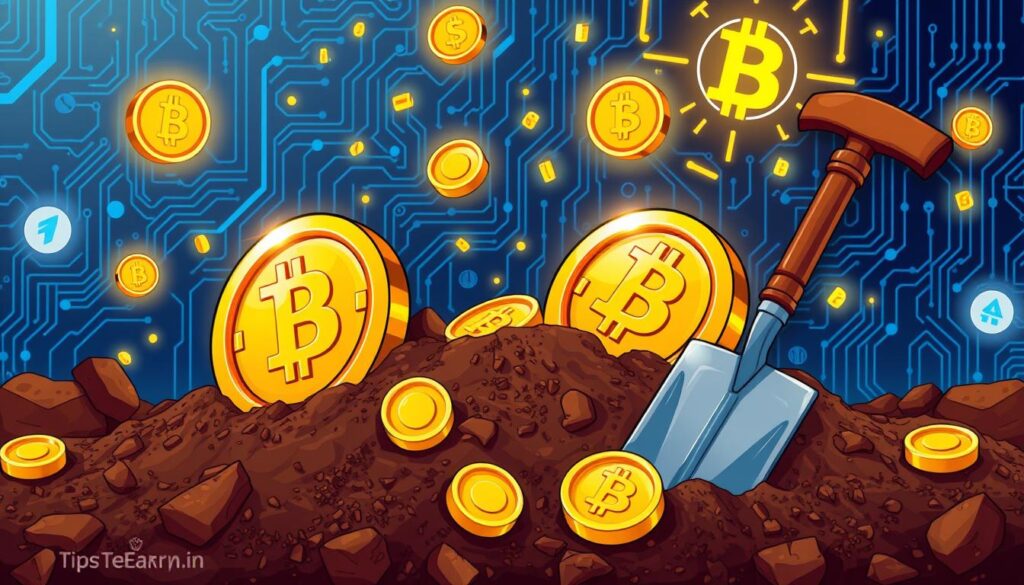In the world of cryptocurrencies, mineable coins are key. They help create and spread digital money. These coins are important in the blockchain world. They reward those who help keep the network safe and working.
Cryptocurrency mining is at the heart of mineable coins. Miners use strong computers to solve hard math problems, called “proof-of-work.” When they solve these problems, they get new digital coins. This makes them want to keep the network safe.
It’s important to know about mineable coins if you’re into cryptocurrencies. We’ll cover the basics, how they’ve changed over time, and how mining works. We’ll also talk about how mining affects the environment and if it’s profitable for miners.
Key Takeaways

- Mineable coins are digital currencies made and spread through mining.
- Mining solves math problems to validate transactions and add blocks to the blockchain. Miners get new coins as rewards.
- Blockchain technology is crucial for mineable cryptocurrencies. It makes transactions secure and decentralized.
- The mining process is vital for creating and spreading digital currencies. It helps keep the cryptocurrency world stable.
- Knowing about mineable coins is essential for anyone interested in the cryptocurrency market and its opportunities.
Understanding Mineable Coins: The Basics
Mineable cryptocurrencies are a key part of digital finance. They are made through crypto mining, which uses blockchain to check transactions and create new coins. This guide will cover the main parts, blockchain’s role, and how mineable coins are made.
Key Components of Mineable Cryptocurrencies
Mineable cryptocurrencies rely on important parts to stay safe and secure. These include proof-of-work, which makes miners solve hard math problems to check transactions. They also use a blockchain, or a shared ledger, to keep track of all transactions.
The Role of Blockchain in Mining
The blockchain is vital in mining. It’s a shared, open, and safe record of all transactions. Miners use their computers to solve puzzles to add new blocks to the chain. They get blockchain rewards, like new coins, for their work, which keeps the network going.
Digital Currency Creation Process
- Miners use strong hardware and special software to solve the proof-of-work challenges.
- Those who succeed get new coins, which are then added to the blockchain.
- This mining process is how new digital currency is made and added to the market.
Learning about mineable coins helps us understand how decentralized digital finance works.
The History and Evolution of Crypto Mining
Cryptocurrency mining has changed a lot since Bitcoin started in 2009. Bitcoin was the first digital currency without a central bank. It introduced mining, a key part of the blockchain world.
At first, people used their computers to mine. They helped validate transactions and got rewards. But, as more people joined, mining got harder and more complex. This led to the creation of special mining hardware called ASICs.
ASICs made mining much faster than regular computers. This change led to big mining farms. These farms used many ASICs to compete better.
As mining got harder, miners had to keep upgrading their gear. This race to get the best mining rigs is ongoing. Miners keep trying to stay ahead by getting the latest and strongest rigs.
New tech has also changed mining. For example, Ethereum’s Proof-of-Stake in 2022 made mining less energy-hungry. This is a big change from the old Proof-of-Work method.
Now, mining is a global business. It’s found in many places and helps the digital currency world grow. As tech keeps improving, we’ll see more changes in this fast-paced industry.
How Cryptocurrency Mining Actually Works
Cryptocurrency mining is key to blockchain technology. It makes and checks digital currency deals. Powerful mining rigs and special software work together to keep the network safe and earn rewards. Let’s explore how this system works.
Mining Hardware Requirements
For effective mining, you need special hardware like ASICs or GPUs. These rigs do the hard math to check transactions and add new blocks. The power of these machines, shown in hashes per second (H/s), affects how much they can earn.
Software Essentials for Mining
- Mining software: Miners use tools like Claymore, CGMiner, or PhoenixMiner to manage mining, set up rigs, and join mining pools.
- Wallet software: Miners use secure wallets like Electrum, Exodus, or MetaMask to keep their rewards safe.
- Monitoring tools: Tools like HiveOS, WinMiner, or CoinWarz help miners watch their mining, check profits, and improve performance.
Network Validation Process
The mining process solves tough math problems to add new deals to the blockchain. Miners race to solve these problems first. The winner gets a set amount of cryptocurrency, like Bitcoin or Ethereum. This keeps the blockchain safe and reliable.
Cryptocurrency mining is complex and always changing. It needs a good grasp of hardware, software, and blockchain tech. Understanding these parts helps us see how mining supports digital currencies’ growth and use.
Proof-of-Work vs Other Consensus Mechanisms
In the world of cryptocurrencies, proof-of-work (PoW) has been key for many blockchain networks, like Bitcoin. But, new consensus mechanisms have come up, each with its own benefits and challenges. Knowing about these different methods helps us understand mining and blockchain security.
The mining difficulty and blockchain rewards tie to the consensus model. PoW uses lots of energy to check transactions and add blocks, keeping the network safe. On the other hand, proof-of-stake (PoS) lets users with a stake in the crypto validate transactions, using less energy.
| Consensus Mechanism | Key Characteristics | Impact on Mining |
|---|---|---|
| Proof-of-Work (PoW) | Energy-intensive computational power to validate transactions | High mining difficulty, rewards based on computational power |
| Proof-of-Stake (PoS) | Validation based on the user’s existing stake in the cryptocurrency | Reduced mining difficulty, rewards based on stake size |
| Delegated Proof-of-Stake (DPoS) | Users elect delegates to validate transactions on their behalf | Moderate mining difficulty, rewards based on delegation |
The debate between PoW and other consensus mechanisms will shape mining and blockchain’s future. It’s important for miners and crypto fans to understand these differences. This knowledge helps them make smart choices in the ever-changing world of digital assets.

“The choice of consensus mechanism is a critical design decision that can significantly impact the security, scalability, and decentralization of a blockchain network.”
Popular Mineable Coins in Today’s Market
The world of cryptocurrency is always changing. “Mineable coins” have become very popular. These digital assets are made through crypto mining. They offer a chance to join the decentralized financial world.
Let’s look at some top mineable coins. They are exciting for both new and experienced crypto fans.
Bitcoin Mining Overview
Bitcoin is the top mineable coin. Mining Bitcoin is hard and uses a lot of energy. But, it can be profitable if you have the right equipment and power.
Ethereum Mining Specifics
Ethereum is the second-largest coin and is also popular for mining. Mining Ethereum is similar to Bitcoin but has its own needs. Miners must keep up with new tech and updates.
Alternative Mineable Cryptocurrencies
There are many other mineable coins besides Bitcoin and Ethereum. Coins like Litecoin, Monero, and Zcash offer different features. They appeal to different miners. Learning about these coins can help diversify your mining.
| Cryptocurrency | Algorithm | Mining Hardware | Average Hashrate |
|---|---|---|---|
| Bitcoin | SHA-256 | ASIC | 180 TH/s |
| Ethereum | Ethash | GPU | 500 MH/s |
| Litecoin | Scrypt | ASIC | 400 GH/s |
| Monero | RandomX | CPU/GPU | 2 KH/s |
The crypto mining world is always changing. It’s key to stay updated on mineable coins. Knowing about these coins helps make better choices for mining and investing.
“Cryptocurrency mining is not just about earning digital wealth – it’s about contributing to the decentralization and security of the underlying blockchain networks.”
Essential Mining Hardware and Equipment
Cryptocurrency mining is a complex process that needs special hardware and equipment. As fans of cryptocurrency, we’ll look at the key parts for a good mining rig. We’ll also see how they affect mining profits.
The core of mining is the mining hardware and mining rigs. These devices, with strong processors and graphics cards, do the hard work. They check transactions and create new coins. The better the rigs, the more profit you can make.
The Anatomy of a Mining Rig
A mining rig has several important parts:
- High-performance GPU (Graphical Processing Unit) or ASIC (Application-Specific Integrated Circuit) chips
- Motherboard made for mining
- Efficient power supply unit (PSU)
- Cooling systems to handle the heat
- Storage like SSDs or HDDs
- Connectivity items, like network cards and cables
Choosing the right mining hardware is key. It affects mining profitability. Top GPUs or ASIC miners boost hash rate and energy use. But, they cost more upfront.
| Mining Hardware | Hash Rate | Power Consumption | Estimated Profitability |
|---|---|---|---|
| NVIDIA RTX 3080 GPU | 100 MH/s | 320W | $3 – $5 per day |
| Antminer S19 Pro ASIC | 110 TH/s | 3250W | $15 – $20 per day |
| AvalonMiner 1246 | 90 TH/s | 3420W | $12 – $16 per day |
The mining hardware you choose greatly affects mining profitability. Knowing what each rig can do and how much power it uses is key. This helps you make smart choices and increase your earnings.
Mining Software Solutions and Tools
Crypto mining is getting more popular, leading to many mining software solutions and tools. These platforms offer different features to help miners. They are designed for mining cryptocurrencies like Bitcoin and Ethereum.
Popular Mining Software Comparison
Some top mining software solutions include:
- CGMiner – A widely-used, open-source GPU mining software known for its reliability and customization options.
- BFGMiner – A versatile mining software that supports multiple algorithms and hardware types, including ASICs and FPGAs.
- EthOS – A Linux-based operating system designed specifically for Ethereum mining, providing a streamlined and efficient mining experience.
- NiceHash Miner – A user-friendly mining software that automatically selects the most profitable mining algorithms and coins based on current market conditions.
Configuration and Setup Guidelines
Setting up mining software right is key to making your mining profitable. You need to:
- Choose the right mining algorithm and pool for your hardware and preferred cryptocurrencies.
- Set up the software’s settings, like mining intensity, pool connection details, and payout preferences.
- Make sure the software works with your mining hardware and operating system. Install any needed drivers or dependencies.
- Keep an eye on the mining process and fix any problems, like hardware failures or network issues.
Using the right mining software and following setup best practices can boost your mining profitability. It makes your crypto mining operations more efficient.
Understanding Mining Pools and Their Benefits
In the world of cryptocurrency mining, mining pools are key for miners wanting to make more money. These pools are groups of miners working together. They use their combined power to solve problems and earn rewards.
One big plus of mining pools is sharing risks and rewards. Miners get smaller, steady payouts instead of big, unpredictable ones. This makes their income more stable and easier to plan.
| Mining Pool | Advantages | Disadvantages |
|---|---|---|
| Slush Pool | Experienced and reliable pool operator Supports a variety of cryptocurrencies Relatively low fees | Can be more technically complex for beginners Relatively lower payouts compared to some other pools |
| F2Pool | One of the largest and oldest mining pools Supports a wide range of cryptocurrencies Offers competitive payout structures | Can have higher fees than some smaller pools May require more technical expertise to set up and manage |
When picking a mining pool, look at its reputation, fees, payout methods, and supported cryptocurrencies. The right pool can help miners earn more and enjoy the rewards of mining pools.

Mining Profitability and ROI Calculations
The world of cryptocurrency mining is always changing. It’s key to know what affects mining profits and how to figure out the return on investment (ROI). We’ll look at important factors like energy costs and the cost of mining hardware.
Energy Cost Considerations
Energy costs are a big part of mining profits. The amount of energy needed can change a lot. It depends on the mining hardware and where it’s located.
Miners need to check their energy costs. This includes electricity, cooling, and any special deals. This helps keep mining profitable.
Hardware Investment Analysis
The cost of mining hardware is also very important. Miners should think about how well the hardware works, how much energy it uses, and how long it lasts. This helps them choose the best hardware for their money.
| Mining Hardware | Hashrate | Power Consumption | Price |
|---|---|---|---|
| Antminer S19 Pro | 110 TH/s | 3,250W | $3,500 |
| ViaBTC V9 | 90 TH/s | 3,096W | $2,800 |
| Whatsminer M30S++ | 112 TH/s | 3,472W | $3,800 |
By looking at energy costs and hardware investment, miners can understand their mining’s potential profits and ROI. This helps them make smart choices and get the most from their mining.
Mining Difficulty and Network Hash Rate
In the world of cryptocurrency mining, two key factors are important: mining difficulty and network hash rate. These are closely related, and knowing how they work together is crucial for keeping mining profitable.
Mining difficulty is how hard it is to add new blocks to the blockchain. When more miners join, the difficulty goes up. This keeps the blockchain secure and reliable.
The network hash rate shows the total power of all miners. A higher hash rate means a safer blockchain. It makes it harder for one person to control the network.
The relationship between mining difficulty and network hash rate is opposite. When difficulty goes up, miners need better hardware or smarter strategies to stay profitable. On the other hand, a higher hash rate means more difficulty, which can lower the rewards for miners.
Successful miners keep an eye on these metrics and adjust their plans. By knowing the latest about mining difficulty and hash rate, they can improve their mining operations and earn more.
“Staying ahead of the curve in mining difficulty and network hash rate is the key to sustained profitability in the cryptocurrency space.”
In short, understanding mining difficulty and network hash rate is key for miners to stay competitive in the fast-changing world of cryptocurrency.
Environmental Impact of Cryptocurrency Mining
Crypto mining has grown fast, raising environmental worries. The need for Bitcoin and Ethereum has increased, making mining’s energy use a big issue. This section looks at the problems and possible fixes for crypto mining’s environmental effects.
Energy Consumption Concerns
Crypto mining uses a lot of energy and electricity. This has upset many who care about the planet. Mining uses more energy than some countries, adding to global warming.
Sustainable Mining Solutions
The mining world is looking for ways to be greener. New ideas include:
- Using solar, wind, and water power to run mines.
- Creating mining gear that uses less energy.
- Starting programs to offset carbon emissions from mining.
- Trying new ways to agree on transactions that use less energy.
These steps could make mining much less harmful to the environment. They could lead to a cleaner future for digital money.
The crypto mining world needs to focus on being green. By finding new, eco-friendly ways, mining can help the planet. This way, mining can be part of a greener future for everyone.
Conclusion
As we wrap up our look at mineable coins and cryptocurrency mining, we’ve learned a lot. We’ve seen how digital currency is made and the key role of blockchain technology. We’ve covered the basics of mineable cryptocurrencies and how they’ve evolved over time.
Miners play a key role in keeping blockchain networks safe and secure. We’ve looked at what’s needed to mine coins, like Bitcoin and Ethereum. We’ve also talked about the pros and cons of mining, including its impact on the environment.
The use of cryptocurrencies is growing worldwide. This means more demand for mineable coins and better mining methods. We expect the mining industry to keep improving, making mining more efficient and sustainable. Blockchain rewards will be crucial in this journey towards a better digital economy.
IF YOU LIKE THIS ARTICLE THEN CLICK HERE TO EXPLORE MORE
